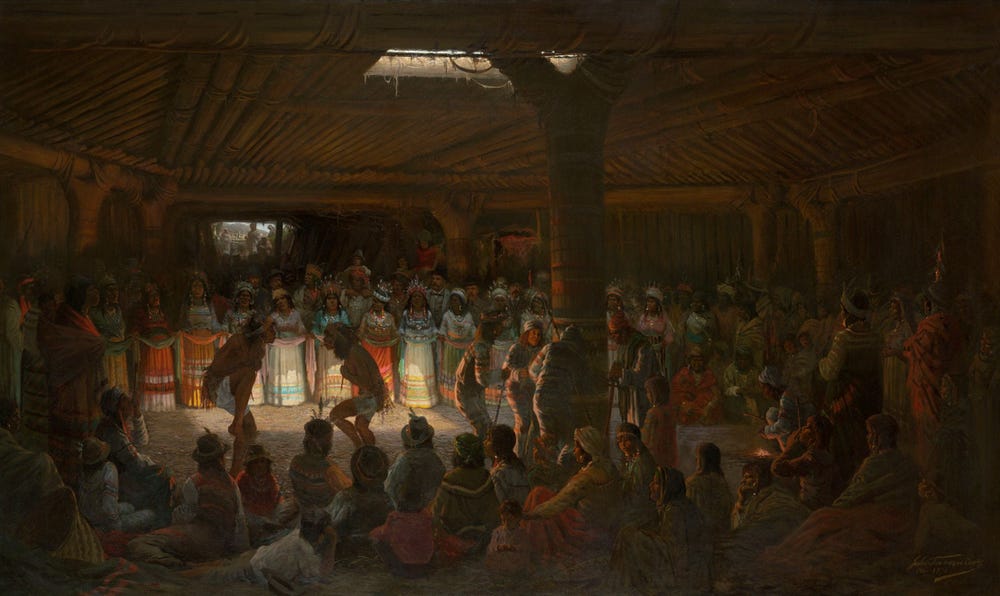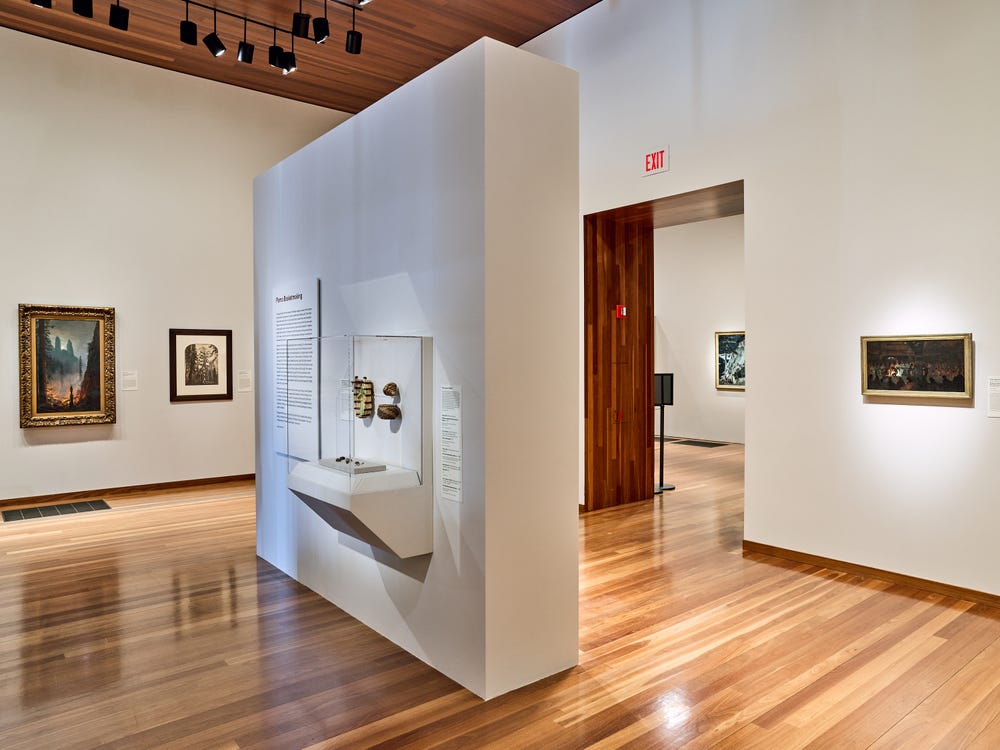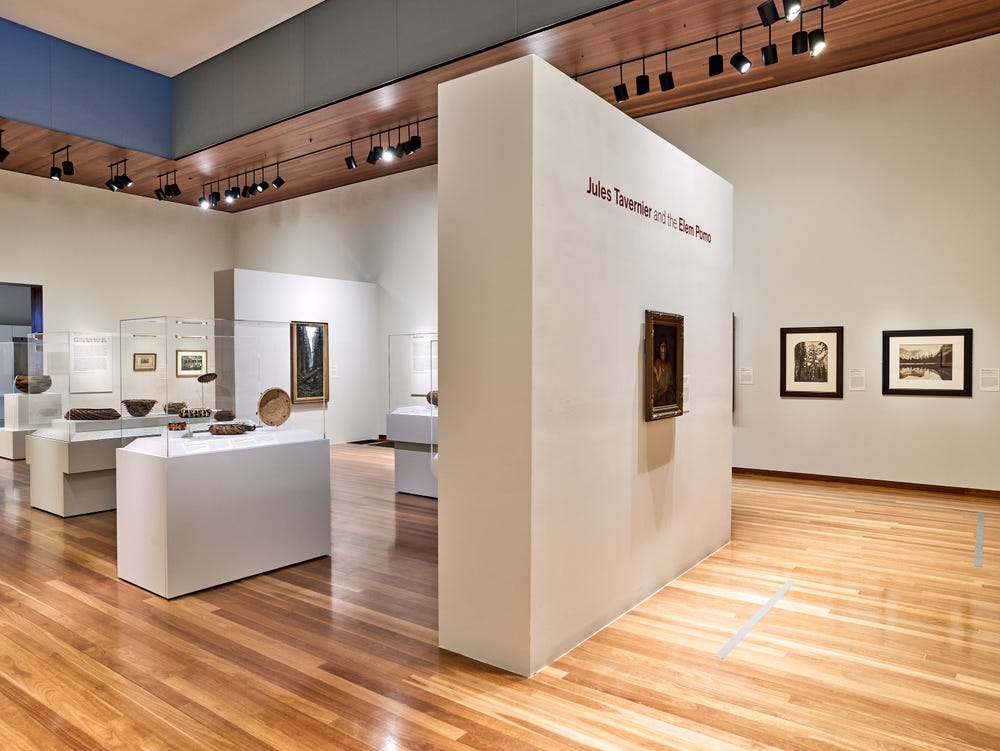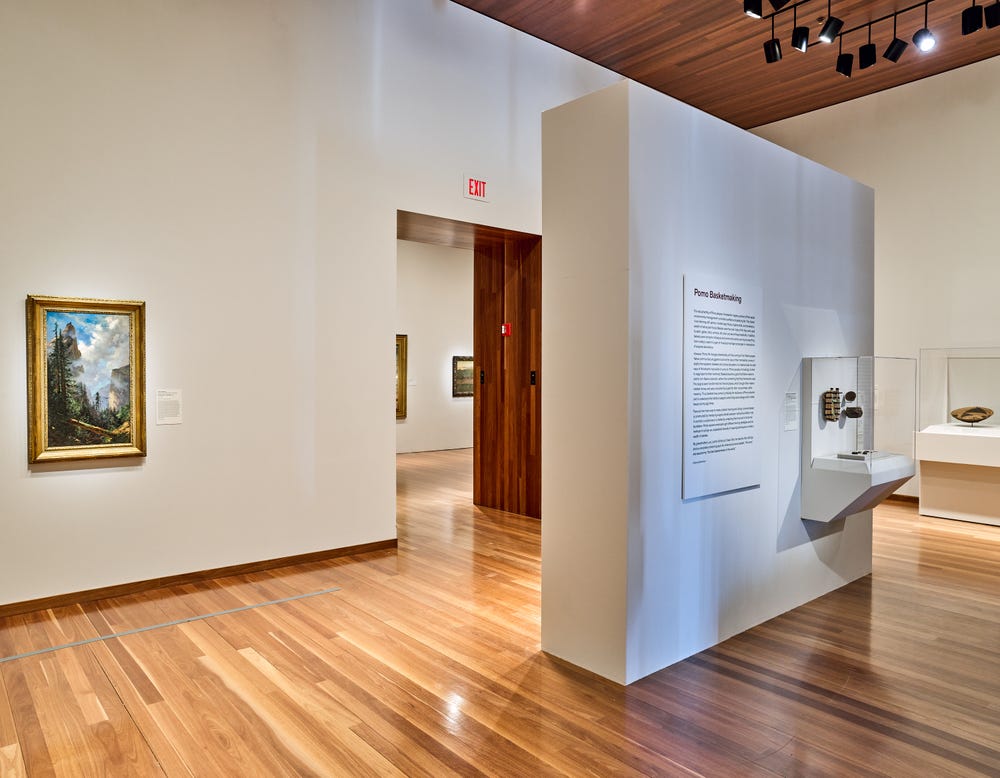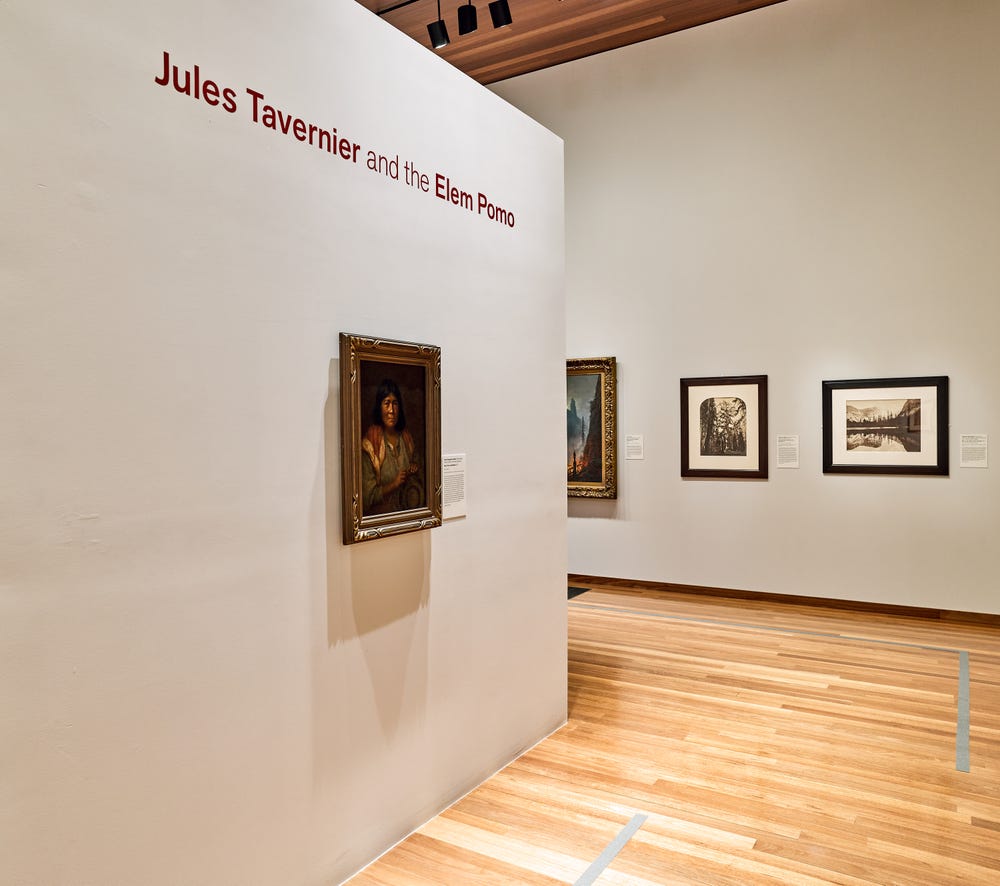Jules Tavernier and the Elem Pomo reveals a remarkable story about California history and Indigenous communities
Dec 2, 2021
Jules Tavernier, Dance in a Subterranean Roundhouse at Clear Lake, California, 1878. The Metropolitan Museum of Art, New York, Marguerite and Frank A. Cosgrove Jr. Fund
Jules Tavernier and the Elem Pomo
de Young museum \ December 18, 2021–April 17, 2022
Rediscovered masterwork reveals a remarkable story about California history and Indigenous communities.
Documentary Film: Jules Tavernier and the Elem Pomo
SAN FRANCISCO—The Fine Arts Museums of San Francisco (the “Museums”) are pleased to announce the exclusive West Coast presentation of Jules Tavernier and the Elem Pomo. The exhibition steps into the 1870–1880s, a period when white settlers continued to claim and mine lands in California and the West that had been inhabited by Indigenous populations for thousands of years. During this time, landscape painter Jules Tavernier journeyed across the United States, portraying the ceremonies and gatherings he witnessed in the Indigenous homelands and the awe-inspiring beauty of the contested landscapes. Through his compositions and the accounts of Native art historians and cultural practitioners, the exhibition broadens perspectives on the West and highlights the resilience of Indigenous populations.
“Jules Tavernier and the Elem Pomo is a timely exhibition that brings alternative perspectives to narratives that have dominated the interpretation of American history and art from this period,” states Thomas P. Campbell, director and CEO of the Fine Arts Museums of San Francisco. “With insights added from the Elem Pomo community, Tavernier’s Dance in a Subterranean Roundhouse at Clear Lake, California reveals a more complex story of a moment in time, bringing to light the impact that Western expansion had on the Elem Pomo community in Northern California and highlighting the resilience and significant heritage of this community.
Jules Tavernier and the Elem Pomo has special resonance for Robert Geary, Elem Pomo tribal citizen and ceremonial roundhouse leader, who states: “Through this exhibition I hope to educate the world about the beauty of my people and my village. The Elem Xe-xwan (ceremonial roundhouse) still exists today with the ceremonies and the Elemfo (Elem people) whom Tavernier painted in 1878.”
Alongside Tavernier’s recently rediscovered masterpiece Dance in a Subterranean Roundhouse at Clear Lake, California (1878), more than 70 works will be presented, including paintings, prints, watercolors, and photographs by Tavernier, as well as representations of Pomo peoples by his contemporaries. An extraordinary display of over 40 pieces of Pomo basketry and regalia, along with a documentary film highlighting the Native context of Tavernier’s canvas, will celebrate the enduring culture and artistry of Pomo peoples.
The exhibition is copresented with Elem Pomo cultural leader and regalia maker Robert Geary; Dry Creek Pomo scholar Sherrie Smith-Ferri, PhD; and Eastern Pomo artist and curator Meyo Marrufo; with additional contributions from Arthur Amiotte, Oglala Lakota artist and historian; and Healoha Johnston, curator of Asian Pacific American women’s cultural history at the Smithsonian Asian Pacific American Center.
In Detail
Born and trained in France, Jules Tavernier arrived in New York in 1871 and shortly thereafter was commissioned to travel across the US to make a pictorial record of the West. Tavernier and a companion captured scenes from the Indigenous lands currently referred to as Nebraska, Wyoming, California, and the Hawaiian Islands. Here they encountered Native Americans and Native Hawaiians at key moments in their struggles to maintain Indigenous sovereignty over the land and resist settler encroachment. Jules Tavernier and the Elem Pomo explores a series of encounters between the landscape painter Jules Tavernier and Indigenous communities across the US, most notably the Elem Pomo village at Clear Lake, California.
Having settled in San Francisco in the 1870s, Tavernier became one of the city’s leading painters. Over a period of two years, the artist visited the Elem Pomo Indian village, about 100 miles from the city, on several occasions in preparation to create his masterwork Dance in a Subterranean Roundhouse at Clear Lake, California (1878)—the centerpiece of this exhibition.
Capturing a historical moment, Tavernier’s painting chronicles an exceptional cultural interaction between California Indians in their homelands and outsiders—settlers and business investors—on November 22, 1875. In the dramatic scene, Tavernier depicts a ceremonial dance of the Elem Pomo known as mfom Xe, or “people dance.” Taking place in an underground roundhouse, Xe-xwan, the dance was performed to protect the people and the land from the destruction and diseases brought by the new settlers. Among the more than 100 Pomo community members of all ages taking part in the ceremony are three visitors: Mexican-born Tiburcio Parrott y Ochoa, a San Francisco banker and patron of Tavernier who commissioned the painting; his Parisian business partner, Baron Edmond de Rothschild; and French military officer Comte Gabriel Louis de Turenne d’Aynac, who was traveling with Rothschild. Parrott was the new owner and operator of the Sulphur Bank Quicksilver Mining Company on Elem ancestral lands. In the ensuing years, the mine would cause widespread mercury contamination of the lake, greatly affecting the Elem Pomo community.
“Since the Fine Arts Museums are located in California—the ancestral homelands of the Pomo peoples and home to more Native Americans than any other state in the country—we are honored to have the opportunity to present new insights into their history and highlight their enduring artistry and rich contributions to the cultural heritage of Northern California. The Pomo basketry and regalia on view celebrate the enduring craftsmanship and skill of several generations of Pomo artists,” states Christina Hellmich, curator in charge of arts of Africa, Oceania, and the Americas at the Fine Arts Museums of San Francisco.
The roundhouse in Tavernier’s painting—like the one on the same site still in use by the community today—embodies the shape of a basket. The exhibition also explores the story of Pomo basketry. Historically, baskets were life-sustaining vessels used in all aspects of Pomo daily life. To create this variety of vessels, Pomo weavers mastered myriad ways of creating a basket and Pomo baskets are world-renowned for their beauty, mastery of technique, and artistry. In this exhibition, viewers can see how this weaving tradition changed in response to the historic circumstances of Pomo peoples’ lives. The exhibition includes historic baskets made by Susanna Graves; Cora Juarez/Worris; Mary Knight Benson and William Benson; and “Elthie” (Ethel Bogus). Baskets reflect the resilience of Pomo communities through the ability and creativity of weavers to adapt to economic and social change, enabling this core aspect of Pomo culture to survive the devastating effects of colonialism. Weaver Clint McKay (Dry Creek Pomo/Wappo/Wintun), whose works are included in the exhibition, states that “to us it [basketry] is the very essence of who we are as Pomo.” Contemporary pieces by McKay, Corine Pearce (Redwood Valley Little River Band of Pomo) and Susan Billy (Hopland Pomo) show the dynamism of Pomo basketry that continues to evolve with each new generation of artists.
A short documentary film created for the exhibition, narrated by Pomo copresenters Robert Geary, Sherrie Smith-Ferri, and Meyo Marrufo, introduces the audience to Clear Lake and the roundhouse; highlight the importance of the landscape and natural materials in Pomo basketry; and present the environmental and cultural impact of mining and land loss as well as the continuum of Elem Pomo ceremony at the site.
Tavernier became known as a landscape painter, capturing scenes at the locations he traveled to across the US. The exhibition will present several works by Tavernier from Camp Robinson, Nebraska, and Fort Laramie, Wyoming—US military installations near the Red Cloud Agency of Chief Red Cloud—alongside narration by Native art historians, curators, and cultural practitioners, designating these places as embodied lands and ancestral homelands rather than colonialist spaces for exploitation and occupation. The exhibition also includes several distinctive Northern California landscapes by Tavernier, including Around the Campfire (Encampment in the Redwoods) (1875); A Disputed Passage (in the Days of ’46) (1876); Sentinel Rock (1886); and his dramatic and mysterious Monterey landscape Artist’s Reverie, Dreams at Twilight (1876). Distinctive from paintings by an earlier generation of artists portraying Native Americans in vast and seemingly empty landscapes ready for white settlement, Tavernier’s works feature Indigenous survivance and also visualize the aftermath of genocide, land theft, forced relocation, and cultural destruction.
About Jules Tavernier
Born in France, Jules Tavernier trained in Paris and exhibited at the Salon at the early stages of his career. In 1871 he arrived in New York and shortly thereafter was commissioned by Harper’s to travel across the US to make a pictorial record of the West. Tavernier and a companion captured scenes from the Indigenous lands currently referred to as Nebraska, Wyoming, California, and the Hawaiian Islands.
Settling in San Francisco at the end of his journey, Tavernier became one of the city’s leading painters of the 1870s and an early member of the San Francisco Art Association, the Bohemian Club, and a founder of the Monterey Peninsula Art Colony. He became known for adapting the aesthetic of the Barbizon School to California views in intimate and atmospheric landscapes and figural compositions.
During his time in San Francisco, Tavernier spent two years visiting the Elem Pomo Indian village at Clear Lake, California, where he prepared to create Dance in a Subterranean Roundhouse at Clear Lake, California (1878)—the centerpiece of this exhibition. The painting was commissioned by San Francisco’s leading banker Tiburcio Parrott y Ochoa (1840–1894), as a gift for his Parisian business partner, Baron Edmond de Rothschild. Upon its completion in 1878, the painting was hailed in San Francisco newspapers as “by far the most remarkable picture ever painted on the Pacific Coast.” However, after much public anticipation, the painting was shipped immediately to Europe by his patron when Tavernier finished it, and the painting was never shown in the city. It remained in Europe until the Metropolitan Museum of Art, New York, purchased it in 2016. As a result, the work is virtually unknown to West Coast audiences and now returns to California for the first time in over 140 years as a central focus of the exhibition.
In 1884 Tavernier moved to the Kingdom of Hawaii and painted dramatic scenic views such as Sunrise over Diamond Head (1888), which will be presented as part of the exhibition. During his time on the islands, he established the “Volcano School” through a range of illustrious paintings capturing the fiery spectacle of lava eruptions of Kīlauea on the Big Island of Hawai‘i. These paintings helped foster tourism to the crater of Kīlauea and the transformation of a sacred space for Native Hawaiians—the dwelling place of the powerful goddess Pele—into a place of commerce.
About the Elem Pomo Community
Jules Tavernier and the Elem Pomo explores art, historical events, and cultural heritage in the Elem Pomo community specifically, and Pomo peoples more generally from the 1870s–1880s to the present. A community of California Indians located just 100 miles north of San Francisco, the Elem Pomo reside in Clearlake Oaks on the shores of Clear Lake and are officially referred to today as the Elem Indian Colony of Pomo Indians of the Sulphur Bank Rancheria. Loans of historic pieces of Pomo ceremonial regalia are being presented alongside loans from Pomo cultural leader Robert Geary of pieces made by his family, creating an extraordinary display of Pomo regalia aimed at highlighting the rich cultural vitality of Lake County’s Indigenous community. (Geary is an Elem Pomo tribal citizen, ceremonial roundhouse leader, regalia maker, president of the Clearlake Pomo Cultural Preservation Foundation, Elem Xaitsnoo language teacher, and a tribal historic preservation officer.)
deyoungmuseum.org \ @deyoungmuseum
Exhibition Programming
Opening Day Celebration Join us for the public opening celebration ofJules Tavernier and the Elem Pomo on Saturday, December 18. This day will include family activities, a film screening, and mfom Xe (people dance) and Pomo Shake Head dance performances by Elem Pomo dancers. Please find the latest details on this page.
Schedule
2 pm & 4 pm \ Wilsey Court: Dance performances by Elem Pomo dancers.
3 pm \ Koret Auditorium: Film Screening + Q+A with exhibition co-presenters Robert Geary, Sherrie Smith-Ferri, and Meyo Marrufo.
December 15 - Virtual Program Capturing a Moment in Time, California, November 22, 1875
This program explores the exceptional historical event captured by Jules Tavernier through the biographies of the participants and the moment in time chronicled in his painting, Dance in a Subterranean Roundhouse at Clear Lake, California. The painting depicts an exceptional cultural interaction between California Indians in their homelands and outsiders—settlers and business investors—on November 22, 1875. Among the more than one hundred Pomo community members of all ages taking part in the ceremony are three visitors: Mexican-born Tiburcio Parrott y Ochoa, a San Francisco banker and patron of Tavernier who commissioned the painting; his Parisian business partner, Baron Edmond de Rothschild; and French military officer Comte Gabriel Louis de Turenne d’Aynac, who was traveling with Rothschild. Parrott was the new owner and operator of the Sulphur Bank Quicksilver Mining Company on Elem ancestral lands. A panel of speakers will bring the biographies and stories together for a revealing view of the painting and California history.
Exhibition Organization
Jules Tavernier and the Elem Pomo is organized by the Metropolitan Museum of Art, New York and the Fine Arts Museums of San Francisco.
The exhibition is co-curated by Elizabeth Kornhauser, Alice Pratt Brown Curator of American Paintings and Sculpture, and Shannon Vittoria, senior research associate, Metropolitan Museum of Art, New York, in partnership with Christina Hellmich, curator in charge, arts of Africa, Oceania, and the Americas at the Fine Arts Museums of San Francisco.
At the de Young, the exhibition is co-presented with Elem Pomo cultural leader and regalia maker Robert Geary; Dry Creek Pomo scholar Sherrie Smith-Ferri, PhD; and Eastern Pomo artist and curator Meyo Marrufo.
Additional consultation and interpretation at the de Young are provided by Arthur Amiotte, Oglala Lakota artist and historian; and Healoha Johnston, curator of Asian Pacific American women’s cultural history at the Smithsonian Asian Pacific American Center.
Patricia Marroquin Norby (Purépecha), PhD, and associate curator of Native American art at the Metropolitan Museum of Art, is an adviser to the project.
The presentation at the de Young museum is made possible by Denise Littlefield Sobel, lead sponsor of the exhibition, through generous support by Janet Barnes, The Bernard Osher Foundation, and Thomas W. Weisel Family, and additional support by Gail and Alec Merriam.
Visiting \ de Young
The de Young museum is open to the public Tuesday–Sunday, 9:30 am–5:15 pm. General admission is $15. Free admission for Bay Area residents is available on Saturdays. More information regarding tickets can be found at deyoungmuseum.org.
About the Fine Arts Museums of San Francisco
The Fine Arts Museums of San Francisco oversee the de Young museum, located in Golden Gate Park, and the Legion of Honor museum, in Lincoln Park. It is the largest public arts institution in San Francisco, and one of the most visited arts institutions in the United States.
The de Young originated from the 1894 California Midwinter International Exposition in Golden Gate Park and was established as the Memorial Museum in 1895. It was later renamed in honor of Michael H. de Young, who spearheaded its creation. The present copper-clad landmark building, designed by Herzog & de Meuron, opened in October 2005. Reflecting an active conversation among cultures, perspectives, and time periods, the collections on view include American painting, sculpture, and decorative arts from the 17th to the 21st centuries; arts of Africa, Oceania, and the Americas; costume and textile arts; and international modern and contemporary art.
The Fine Arts Museums of San Francisco respectfully acknowledge the Ramaytush Ohlone, the original inhabitants of what is now the San Francisco Peninsula, and acknowledge that the greater Bay Area is the ancestral territory of the Miwok, Yokuts, Patwin, and other Ohlone. Indigenous communities have lived in and moved through this place over hundreds of generations, and Indigenous peoples from many nations make their home in this region today. Please join us in recognizing and honoring their ancestors, descendants, elders, and their communities.
Media Inquiries
Helena Nordstrom, Acting Director of Communications \ hnordstrom@famsf.org \ 415.465.3531
